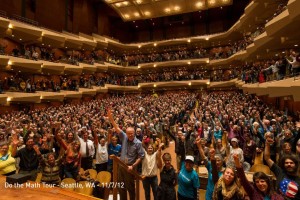Sure. To grasp the seriousness of the climate crisis, you just need to do a little math. Fossil fuel corporations have 5 times more oil and coal and gas in known reserves than climate scientists think is safe to burn. We have to keep 80% of their fossil fuels underground to keep the earth in livable shape.Here are the three numbers you shouldn’t forget:
2 degrees— Almost every government in the world has agreed that any warming above a 2°C (3.6°F) rise would be unsafe. We have already raised the temperature .8°C, and that has caused far more damage than most scientists expected. A third of summer sea ice in the Arctic is gone, the oceans are 30 percent more acidic, and since warm air holds more water vapor than cold, the climate dice are loaded for both devastating floods and drought.
565 gigatons — Scientists estimate that humans can pour roughly 565 more gigatons of carbon dioxide into the atmosphere and still have some reasonable hope of staying below two degrees. Computer models calculate that even if we stopped increasing CO
2 levels now, the temperature would still rise another 0.8 degrees above the 0.8 we’ve already warmed, which means that we’re already 3/4s of the way to the 2 degree target.
2,795 gigatons — The Carbon Tracker Initiative, a team of London financial analysts and environmentalists, estimates that proven coal, oil, and gas reserves of the fossil-fuel companies, and the countries (think Venezuela or Kuwait) that act like fossil-fuel companies, equals about 2,795 gigatons of CO2, or five times the amount we can release to maintain 2 degrees of warming.
A gigaton represents a billion times more mass than a metric ton. Right now, we use about 31 gigatons of carbon a year, and it’s increasing. At our current rate, we’ll blow through our 565-gigaton allowance in 16 years, around the time today’s preschoolers will be graduating from high school.
In short: it just doesn’t make sense for universities to invest in a system that will leave their students no livable planet to use their degrees on, or for pension funds to invest in corporations that will ruin the world we plan to retire in. The one thing we know the fossil fuel industry cares about is money. Universities, pension funds, and churches invest a lot of it. If we start with these local institutions and hit the industry where it hurts — their bottom line — we can get their attention and force them to change. This was a key part of how the world ended the apartheid system in South Africa, and we hope it can have the same effect on the climate crisis.
It’s hard to say exactly — many endowments and funds suffer from a lack of transparency, so it’s impossible to get precise numbers on this question. Here’s what we do know: at today’s market value, the 2,795 gigatons of carbon that the fossil fuel industry already has in its reserves are worth about
$27 trillion. If we need to keep 80 percent of those reserves in the ground, that’s a $20 trillion write off for the industry. We’ll need a lot of pressure.
We’ve organized a big, expensive traveling road show for the tour. Ticket sales go toward covering some of our costs, but won’t cover everything. One thing to note: ticket sales are not tax exempt.
We wish! We’ve had to carefully arrange all the booking details in advance to make sure things go off without a hitch, so booking is closed for now.
Time and budget only allows us to do the tour that we’ve mapped out. But we are just getting started with divestment work, and we’ll have more information about how you can host a local Do the Math event very soon.
We’ve heard a lot from people who want to divest their own savings from fossil fuel companies. That’s a good place to start, but remember that the impact of getting your University’s $1 billion endowment to divest is much, much larger than divesting $100 of your own money.
That said, there are a number of great resources to compare and contrast Socially Responsible funds. As with any investment, take the time to read through all the fine print, and make sure you’re making the right financial choice for you. We’re not money managers, so before you make any decisions, make sure to talk to a professional.
The Forum for Sustainable and Responsible Investment has probably the best comparison of Socially Responsible Mutual Funds available here: http://ussif.org/resources/mfpc
*Please note that most of these funds, while marketed as “socially responsible,” still invest in fossil fuel equities. Part of this fight is pushing money managers at these firms and others to divest from fossil fuels, too.
 Each event was be a unique and interactive experience, unlike any talk you’ve been to before. The presentation picked up where Bill McKibben’s landmark
Each event was be a unique and interactive experience, unlike any talk you’ve been to before. The presentation picked up where Bill McKibben’s landmark 
